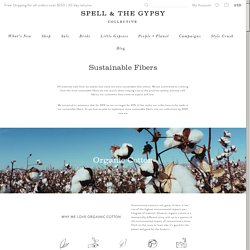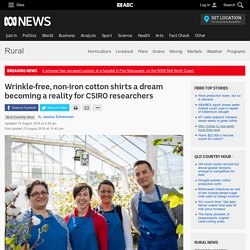

Eco Fashion Basics: Understanding Sustainable Textiles and Fabrics - Eco Warrior Princess. Spell & The Gypsy Collective - Australia. All materials take from our planet, but some are more sustainable than others.

We are committed to creating from the most sustainable fibres we can source whilst staying true to the premium quality, buttery-soft fabrics our customers have come to expect and love. We are proud to announce that for 2019 we are on target for 40% of the styles our collections to be made in our sustainable fibers. To see how we plan to implement more sustainable fibers into our collections by 2025 view our Conventional cotton is not great.
In fact, it has one of the highest environmental impacts per kilogram of material. Non-Genetically Modified: Good for the planet and farmers are not unethically bound to GM multinationals. Farmers work with nature rather than against it. No nasties in the form of synthetic chemicals (fertilizers and pesticides) are allowed. With only a quarter of the environmental impact, the planet is loving organic. International Wool Textile Organisation. Wool is an all-natural, renewable fibre, grown on sheep Wool is a planet-friendly fibre for many reasons: Sheep are part of the natural carbon cycle, consuming the organic carbon stored in plants and converting it to wool.

What Are the Most Sustainable Fabrics? Clothing and textile manufacturing's environmental impact and how to shop more ethically - Science News - ABC News. The shirt you're wearing right now: what's it made from?

In its rawest form, was it once growing in a field, on a sheep's back or sloshing at the bottom of an oil well? We wear clothes literally every day, but few of us spend much time reflecting on what goes into manufacturing various textiles and their environmental impacts. This is interesting considering how much we think about the food we eat or the skin care products we use. Most of us don't realise how environmentally intensive it is to make a single article of clothing, says fashion sustainability expert Clara Vuletich, whose PhD research focuses on sustainable textiles.
"Textile supply chains are some of the most complex of any manufacturing sector," she said. First comes the fibre, which, whether it comes from a plant, animal or crude oil, is almost always an energy and pollutant-intensive process. The fibre is processed until it can be spun into a yarn, which, in turn, is woven or knitted into a fabric. Life cycles "Be conscious. 6 sustainable textile innovations that will change the fashion industry.
Bananas, coffee, pineapple, lotus, stinging nettles and hemp - what sounds like the ingredients on an exotic shopping list are actually all natural resources that can be turned into sustainable textiles. 'How' will be explained below; 'why' should be obvious: In view of dwindling resources, especially through resource-intensive natural fibres like cotton and the environmental impact of petroleum-based fibres like acrylic, polyester, nylon and spandex, it is about time for the textile and apparel industry to look for sustainable alternatives and to prove that the production of textiles and clothing does not have to pollute the environment.

On the contrary. FashionUnited has found six interesting alternatives. 1. Wrinkle-free, non-iron cotton shirts a dream becoming a reality for CSIRO researchers - ABC Rural - ABC News. Not having to iron a cotton shirt and fighting all the creases after being washed or worn could become a reality with a team of CSIRO scientists embarking on a new project developing the next generation of cotton.

The CSIRO research team is aiming to grow a plant with the characteristics of synthetics, providing a stretchy, non-creasing and waterproof fibre, which also retains its natural feel. CSIRO senior research scientist Colleen MacMillan said the team was looking into the structure of cotton cell walls, and putting molecules into the cell walls, giving the plant new properties. "We use special molecular tools called synthetic biology tools that are inspired by nature and exist in nature to produce the next generation of cotton," Dr MacMillan said.
She said the idea was to have a plant that could produce new natural fibres that had some of the properties of synthetics. The fibres could then break down in the environment. Future Fabrics - The Incredible Textiles You'll Soon Be Wearing. The Future It looks like the industry is going back to nature and looking to natural textiles from plants, the ocean and food waste to produce sustainable textiles.

A large portion of ‘sustainable fashion’ items are using a mix of recycled material i.e polyester and natural fabric. This is an ideal situation as it incorporates fabric that would otherwise be sitting in landfill, as long as the production process is eco friendly. Hemp is currently being used already in certain types of clothing, however it hasn’t gone mainstream just yet. Made from the Marijuana plant, it’s a versatile plant and similar to Bamboo in that it’s fast growing and has a low impact on the environment. Chitin Fibre is derived from food waste, predominately from crustaceans shell. Seaweed is apparently a very versatile and low environment impact material, however I can’t see it going mainstream…mainly because…it’s seaweed. Banana Fibre is similar to Bamboo in that it’s versatile when softened and cheap.
The Future. A-Z GLOSSARY OF SUSTAINABLE FIBRES. We know it can be difficult to understand exactly what sustainable fashion means, and the material your clothing is made from plays a BIG role in its environmental impact.

There are a lot of different sustainable fibres and fabrics out there, many of which are on this list. It's a list in progress, and when new fibres enter the market we will continue to update them here. Alpaca Wool Alpaca wool is made from the fleece of the South American alpaca, although often softer than sheep's wool and also hypoallergenic. Alpaca require no pesticides or antibiotic treatment when raised for wool, making their lustrous and durable fleece naturally organic.